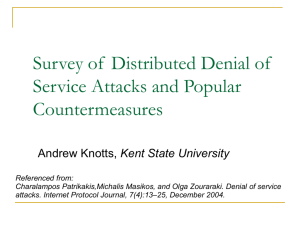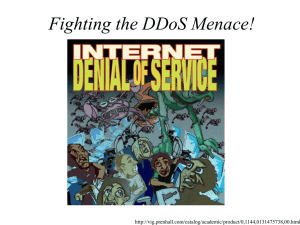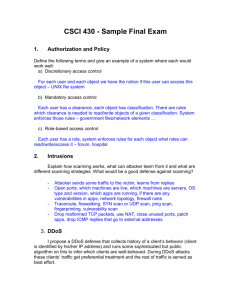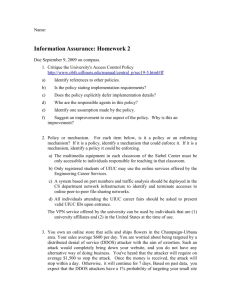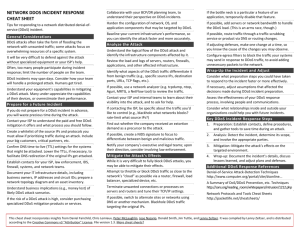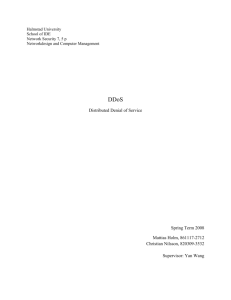Review examples
advertisement
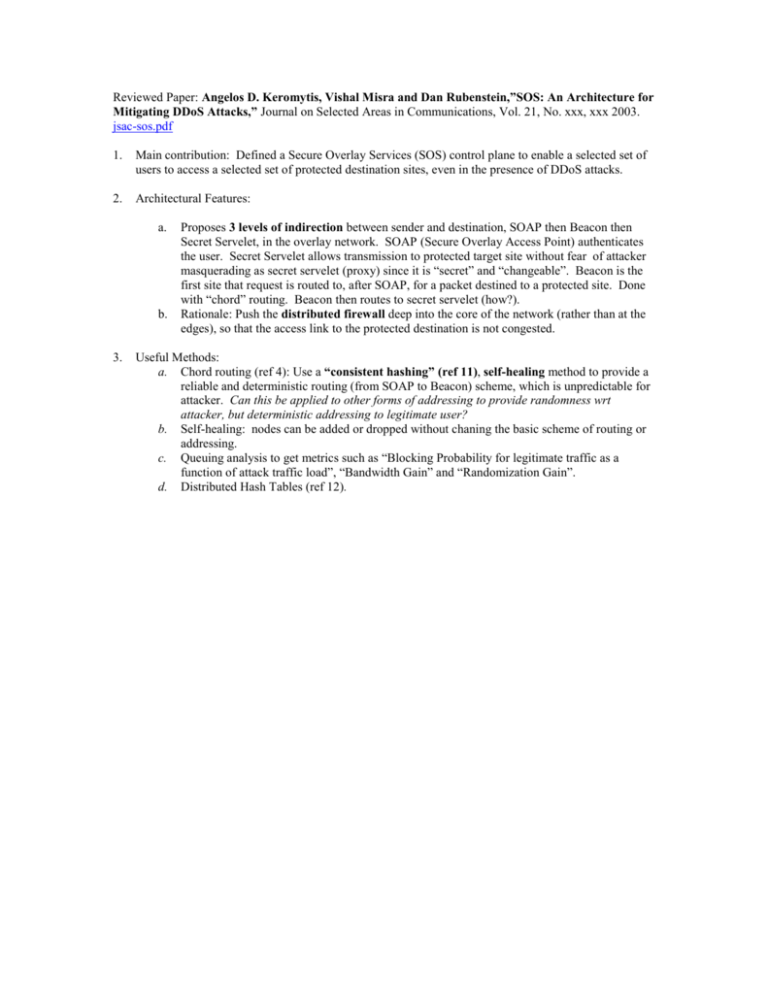
Reviewed Paper: Angelos D. Keromytis, Vishal Misra and Dan Rubenstein,”SOS: An Architecture for Mitigating DDoS Attacks,” Journal on Selected Areas in Communications, Vol. 21, No. xxx, xxx 2003. jsac-sos.pdf 1. Main contribution: Defined a Secure Overlay Services (SOS) control plane to enable a selected set of users to access a selected set of protected destination sites, even in the presence of DDoS attacks. 2. Architectural Features: a. b. 3. Proposes 3 levels of indirection between sender and destination, SOAP then Beacon then Secret Servelet, in the overlay network. SOAP (Secure Overlay Access Point) authenticates the user. Secret Servelet allows transmission to protected target site without fear of attacker masquerading as secret servelet (proxy) since it is “secret” and “changeable”. Beacon is the first site that request is routed to, after SOAP, for a packet destined to a protected site. Done with “chord” routing. Beacon then routes to secret servelet (how?). Rationale: Push the distributed firewall deep into the core of the network (rather than at the edges), so that the access link to the protected destination is not congested. Useful Methods: a. Chord routing (ref 4): Use a “consistent hashing” (ref 11), self-healing method to provide a reliable and deterministic routing (from SOAP to Beacon) scheme, which is unpredictable for attacker. Can this be applied to other forms of addressing to provide randomness wrt attacker, but deterministic addressing to legitimate user? b. Self-healing: nodes can be added or dropped without chaning the basic scheme of routing or addressing. c. Queuing analysis to get metrics such as “Blocking Probability for legitimate traffic as a function of attack traffic load”, “Bandwidth Gain” and “Randomization Gain”. d. Distributed Hash Tables (ref 12). Reviewed Paper: Yoohwan Kim, Wing Cheong Lau, Mooi Choo Chuah and Jonathan H. Chao, “PacketScore: Statistical-based Overload Control against Distributed Denial-of-Service Attacks,” ??? packet_score.pdf 1. Main contributions: Real-time differentiating of packets into “attack” or “legitimate” categories based on a calculated “packetscore”. Packet score depends on score distribution of incoming packets and on current level of system (over)load. Attack packets are discarded, with method to estimate false positives and false negatives. 2. Architectural Features: a. Use of 1) 3D-R (Detect, Differentiate and Discard Routers) at edge routers and 2) DCS (DDoS Control Server) as aggregating servers for online profiling of suspicious traffic compared with normal traffic profile. b. Ingress filtering 3. Useful Techniques: a. Bloom Filters b. Bayesian theoretic approach c. Iceburg style histograms 4. Misc. Useful Facts a. Most dominant legitimate packet has following characteristics: 1500 bytes TCP Server port 80 (http) TCP flag set to ACK Uniformly random IP source address b. WIDE: MAWI traffic archive http://tracer.csl.sony.co.jp/mawi/ 5. Past DDoS Countermeasures (for a survey paper): a. Traffic monitoring and traceback schemes (forensics or possibly real-time) b. Pushback mechanisms (based on traceback identifying real source IPs and attack pkt characterizations). c. Intrusion patterns (via off-line data-mining) d. D-WARD: limited statistical profiling at edge of network to do on-line detection of new patterns of DDoS attacks (stop DDoS at ingress routers)

